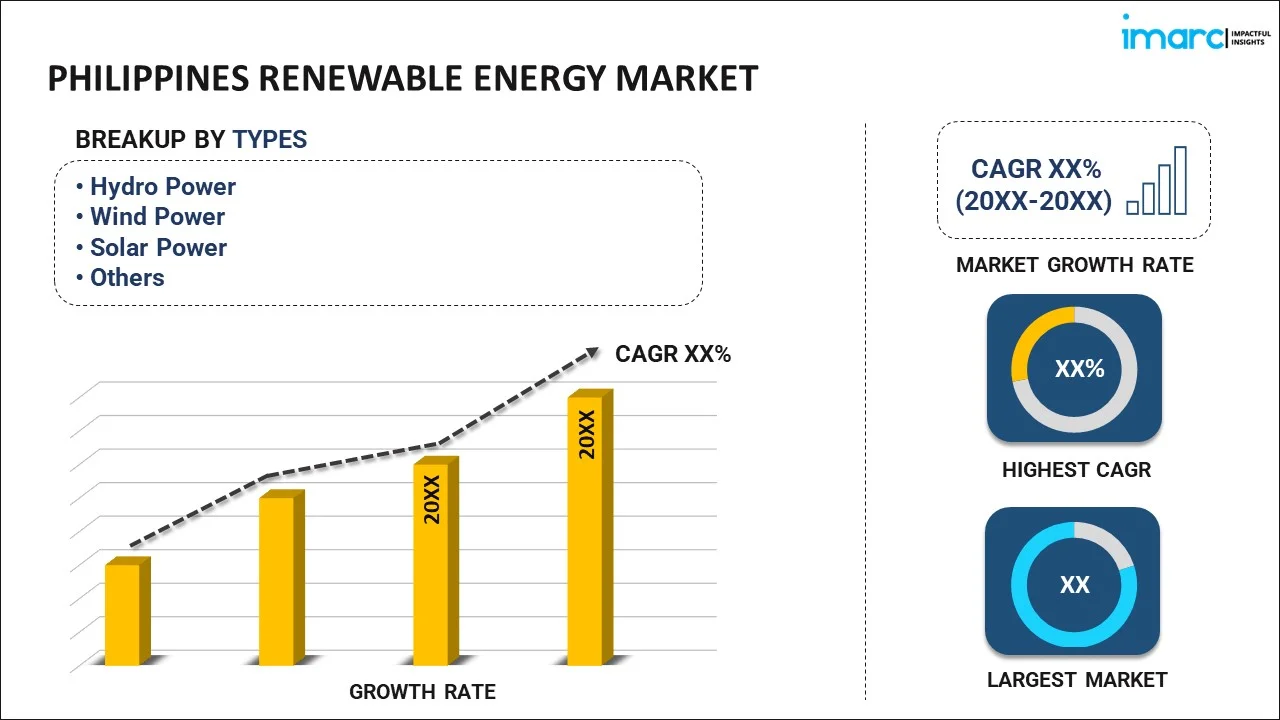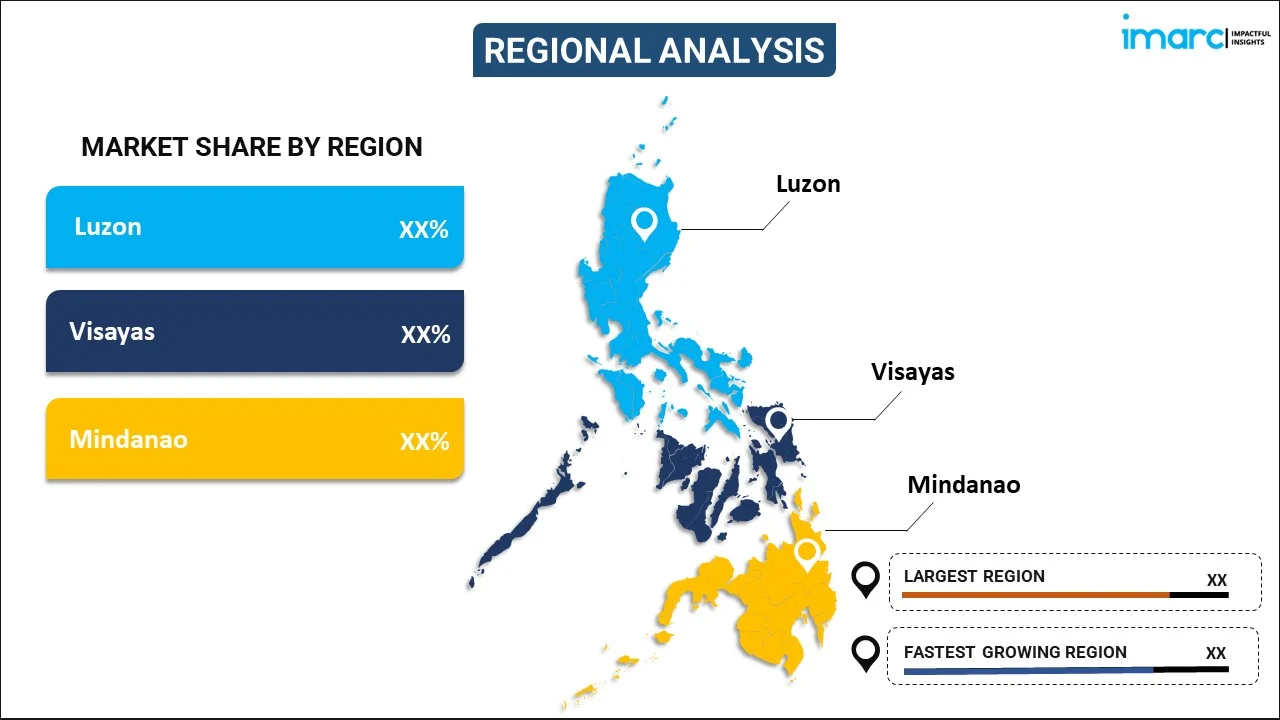
Philippines Renewable Energy Market Report by Type (Hydro Power, Wind Power, Solar Power, Bioenergy, and Others), End User (Industrial, Residential, Commercial), and Region 2025-2033
Philippines Renewable Energy Market Overview:
The Philippines renewable energy market size is projected to exhibit a growth rate (CAGR) of 8.4% during 2025-2033. Supportive government incentives, increasing energy demand, ongoing technological advancements, declining costs of renewable technologies, and growing environmental awareness among consumers and businesses are some of the major factors creating a positive outlook for the market.
|
Report Attribute
|
Key Statistics
|
|---|---|
|
Base Year
|
2024 |
|
Forecast Years
|
2025-2033
|
|
Historical Years
|
2019-2024
|
| Market Growth Rate (2025-2033) | 8.4% |
Philippines Renewable Energy Market Trends:
Government initiatives and regulatory support
The government has implemented various policies and incentives to promote renewable energy development. This legislation offers fiscal and non-fiscal incentives to renewable energy projects, including tax holidays, duty-free importation of equipment, and priority dispatch in the electricity market. Additionally, the government has set ambitious targets to increase the share of renewables in the energy mix, aiming to reduce dependence on fossil fuels and enhance energy security. In line with these efforts, the Philippines has launched a tender for 2 GW of renewable energy projects under its Green Energy Auction Program. Through this auction, the Department of Energy intends to distribute 1.26 GW of solar, 380 MW of wind, 180 MW of biomass, and 80 MW of hydropower capacity. These regulatory frameworks and supportive policies create a favorable environment for the growth of renewable energy projects, attracting both local and international investors.
Technological advancements
Innovations in solar, wind, hydro, and biomass technologies have led to increased efficiency and reduced costs, making renewable energy more competitive with traditional energy sources. For instance, the cost of solar panels has decreased dramatically due to advances in photovoltaic (PV) technology, increasing the viability of solar energy projects from a financial standpoint. Similarly, improvements in wind turbine design and manufacturing have enhanced the efficiency and reliability of wind power generation. Moreover, the development of smart grid technologies and energy storage solutions, such as batteries, also plays a crucial role in integrating renewable energy into the national grid, ensuring a stable and reliable power supply. These technological advancements enhance the performance and cost-effectiveness of renewable energy projects, bolstering the market growth.
Increasing private sector investment
Recognizing the potential for profitable returns, private companies and investors are increasingly investing in renewable energy projects. This trend is fueled by the availability of attractive financing options and the growing demand for sustainable energy solutions. Private sector participation ranges from large-scale utility projects to small and medium-sized enterprises (SMEs) focusing on distributed generation and off-grid solutions. The entry of private players brings in much-needed capital, innovation, and expertise, accelerating the development and deployment of renewable energy technologies. Furthermore, corporate social responsibility (CSR) initiatives and sustainability goals are prompting businesses to invest in renewable energy as part of their commitment to reducing carbon footprints and promoting environmental stewardship is aiding the market expansion.
Philippines Renewable Energy Market News:
- In February 2023, Alternergy Holdings Corp. announced the acquisition of three service contracts for its offshore wind projects across Tablas Strait in the Philippines. For the Tablas Strait offshore wind initiative, Pililla AVPC Corp., the company's wind unit, has been granted these contracts by the Philippines Department of Energy (DoE).
- In November 2023, ACCIONA Energía, in partnership with local company Freya Renewables, secured development rights for a 160MW wind farm in The Philippines. The contract for the exploration, development, and use of wind resources in Pantabangan municipality was given by the Philippine Department of Energy (DOE) through its fourth Open and Competitive Selection Process (OCSP4) for renewable energy resources.
Philippines Renewable Energy Market Segmentation:
IMARC Group provides an analysis of the key trends in each segment of the market, along with forecasts at the country level for 2025-2033. Our report has categorized the market based on type and end user.
Type Insights:

- Hydro Power
- Wind Power
- Solar Power
- Bioenergy
- Others
The report has provided a detailed breakup and analysis of the market based on the type. This includes hydro power, wind power, solar power, bioenergy, and others.
End User Insights:
- Industrial
- Residential
- Commercial
A detailed breakup and analysis of the market based on the end user have also been provided in the report. This includes industrial, residential, and commercial.
Regional Insights:

- Luzon
- Visayas
- Mindanao
The report has also provided a comprehensive analysis of all the major regional markets, which include Luzon, Visayas, and Mindanao.
Competitive Landscape:
The market research report has also provided a comprehensive analysis of the competitive landscape in the market. Competitive analysis such as market structure, key player positioning, top winning strategies, competitive dashboard, and company evaluation quadrant has been covered in the report. Also, detailed profiles of all major companies have been provided.
Philippines Renewable Energy Market Report Coverage:
| Report Features | Details |
|---|---|
| Base Year of the Analysis | 2024 |
| Historical Period | 2019-2024 |
| Forecast Period | 2025-2033 |
| Units | Gigawatt |
| Scope of the Report | Exploration of Historical and Forecast Trends, Industry Catalysts and Challenges, Segment-Wise Historical and Predictive Market Assessment:
|
| Types Covered | Hydro Power, Wind Power, Solar Power, Bioenergy, Others |
| End Users Covered | Industrial, Residential, Commercial |
| Regions Covered | Luzon, Visayas, Mindanao |
| Customization Scope | 10% Free Customization |
| Post-Sale Analyst Support | 10-12 Weeks |
| Delivery Format | PDF and Excel through Email (We can also provide the editable version of the report in PPT/Word format on special request) |
Key Questions Answered in This Report:
- How has the Philippines renewable energy market performed so far and how will it perform in the coming years?
- What has been the impact of COVID-19 on the Philippines renewable energy market?
- What is the breakup of the Philippines renewable energy market on the basis of type?
- What is the breakup of the Philippines renewable energy market on the basis of end user?
- What are the various stages in the value chain of the Philippines renewable energy market?
- What are the key driving factors and challenges in the Philippines renewable energy?
- What is the structure of the Philippines renewable energy market and who are the key players?
- What is the degree of competition in the Philippines renewable energy market?
Key Benefits for Stakeholders:
- IMARC’s industry report offers a comprehensive quantitative analysis of various market segments, historical and current market trends, market forecasts, and dynamics of the Philippines renewable energy market from 2019-2033.
- The research report provides the latest information on the market drivers, challenges, and opportunities in the Philippines renewable energy market.
- Porter's five forces analysis assist stakeholders in assessing the impact of new entrants, competitive rivalry, supplier power, buyer power, and the threat of substitution. It helps stakeholders to analyze the level of competition within the Philippines renewable energy industry and its attractiveness.
- Competitive landscape allows stakeholders to understand their competitive environment and provides an insight into the current positions of key players in the market.
Need more help?
- Speak to our experienced analysts for insights on the current market scenarios.
- Include additional segments and countries to customize the report as per your requirement.
- Gain an unparalleled competitive advantage in your domain by understanding how to utilize the report and positively impacting your operations and revenue.
- For further assistance, please connect with our analysts.
 Inquire Before Buying
Inquire Before Buying
 Speak to an Analyst
Speak to an Analyst
 Request Brochure
Request Brochure
 Request Customization
Request Customization




.webp)




.webp)












